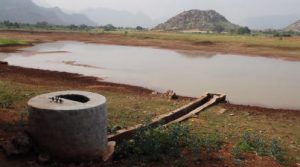Agriculture is generally recognized as the precursor to the world’s first civilizations. The development of irrigation and other farming methods boosted food production and allowed for population expansion and permanent human settlements. Irrigated land expanded at a steady pace until the last century with the advent of modern farming techniques. Modern farming tripled acreage of irrigated land between 1950 and 2000 (Brown). However, with increased irrigation comes increased water consumption.
Water scarcity is a primary obstacle to the world’s food security. According to the Food and Agriculture Organization of the UN, only 20% of cultivated land is irrigated but it produces 40% of the world’s food (2014). In order to irrigate this land, it requires about 70% of the world’s freshwater supplies (Brown). Whether surface water or groundwater is used for irrigation, current methods are stressing freshwater reserves to their limits. Surface water is collected in dams where it is susceptible to evaporation, or groundwater is pumped from aquifers at rates that exceed their ability to replenish. What’s worse, some locations rely on fossil aquifers which cannot be replenished at all (Brown).
If we want to ensure there is enough freshwater to continue feeding the planet in the coming decades, we need to investigate alternative methods of sourcing and supplying water for irrigation. In the state of Tamil Nadu in South India, farmers rely on rainwater harvesting to irrigate 61% of their agricultural lands (Van Meter). This ancient method was the primary form of irrigation for over a thousand years, until more modern methods became favored during the colonial era, including an increase in wells accessing groundwater (Van Meter). So many wells were constructed in Tamil Nadu that groundwater levels dropped significantly, resulting in many of them drying up. Because of this, there has been a recent revival of rainwater harvesting systems to compensate for the damage done by over-pumping.

Rainwater Harvesting Tank in Tamil Nadu | Source: http://pubs.acs.org/action/showImage?doi=10.1021%2Fes4040182&iName=master.img-000.jpg&w=238&h=133&
Rainwater harvesting is one example of a sustainable irrigation method that can effectively intervene in issues of water scarcity and food security. While more research must be done to evaluate the scalability of such a system on a global level, it is measures like these that demonstrate the kind of holistic thinking the world needs to combat these impending challenges.
Sources:
Brown, L. R. (2012). Full planet, empty plates: the new geopolitics of food scarcity. New York: Norton.
Van Meter, K., Basu, N., Tate, E., & Wyckoff, J. (2014). Monsoon harvests: The living legacies of rainwater harvesting systems in South India. Environmental Science & Technology, 48(8), 4217-25.
